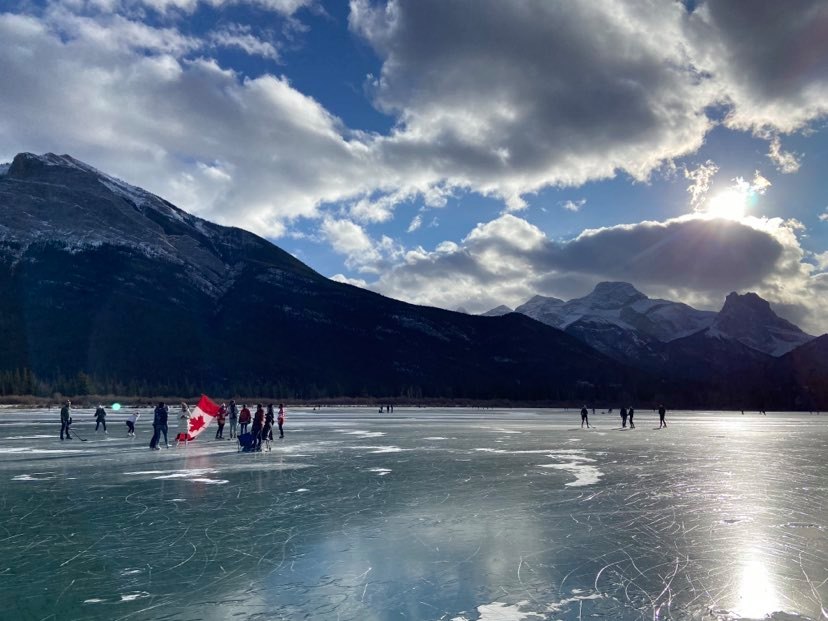Seven Alberta Mountain Lakes to Ice Skate with the Family
Big peaks and dramatic shorelines make Bow Valley lakes some of the best in Canada to experience wild ice skating

Mountain lake ice skating has boomed in Alberta over the past few months, with thousands of people heading to the hills. Read about the boom of mountain lake skating here.
There are dozens of lakes in the Bow Valley, Kananaskis Country, Spray Valley and beyond where families can enjoy the great outdoors while playing hockey or simply just cruising around.
Conditions in Alberta’s mountains have been prime this year for ice skating. Thanks to the low amounts of snow accumulation, cold nights and windy days, most lakes are frozen smooth with few bumps, cracks or snow piles.
Below are five must-skate lakes in the Bow Valley, and below them are backcountry skating tips for beginners.
Spray Lakes
Spray Lakes is a big human-made body of water in the Spray Valley Provincial Park south of Canmore on the Smith Dorrien Trail highway. In summer, a campground and hiking trail draws thousands of people to its shores.
You can reach the lake in about 25 minutes from Canmore and there’s plenty of parking along side-roads near the lake. Access from the shore is rocky, but with few steep drops. A fun, easy lake for the whole family.
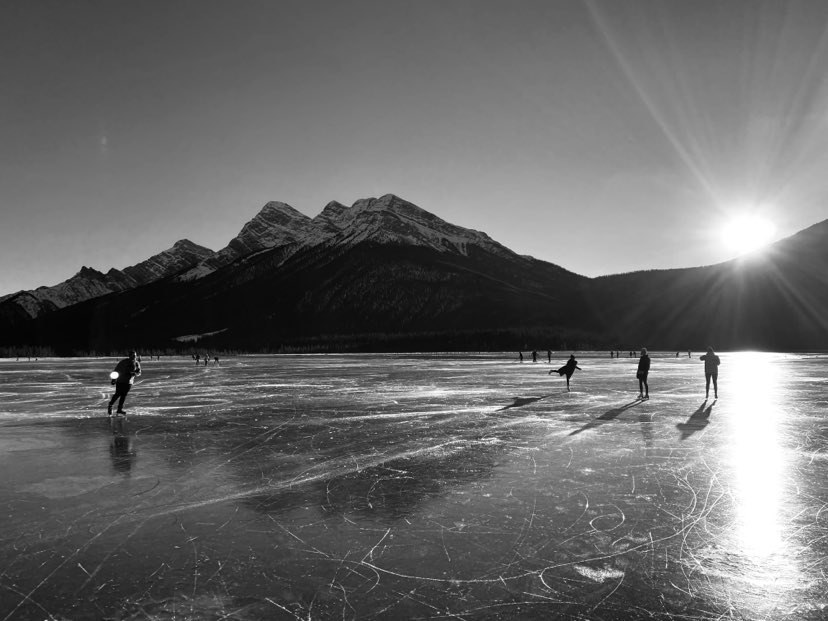
Gap Lake
Gap Lake is on the south side of Highway 1A between Exshaw and Canmore. In summer, there’s a boat launch and picnic area and the lake is popular with paddlers.
In winter, the lake is busy with ice skaters who come from far and wide. The lake is pretty big and offers some cool shoreline geography that’s worth checking out. There’s limited parking (don’t park on the highway), so if it’s full you have to go elsewhere.
Johnson Lake
Johnson Lake is one of Banff National Park’s most popular in summer for paddling and swimming, but in winter it becomes busy with ice skaters.
Located on Lake Minnewanka Scenic Dr., you’re sure to see bull elk wandering the fields and possible a bear or two depending on the season. There’s a large parking area, mellow ramp to the ice and a huge surface to skate on.
By mid-season, there are shovelled “rinks” that are perfect for the family to engage in an afternoon of skating or some puck passing.
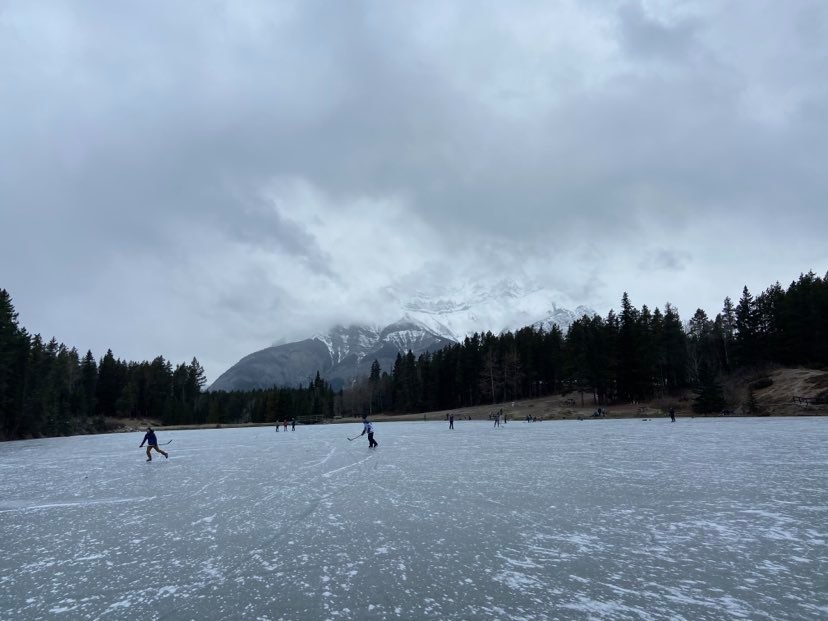
Loon Lake
The little-known Loon Lake is a big pond below Yamnuska in the front-ranges of the Bow Valley. It’s shallow, hosts a lot of birds in summer and becomes the perfect skating rink in winter.
You park at the Yamnuska parking area, walk up the quarry road for five mintues and then head left into the forest on a wide path. Follow it for 500 metres to the lake. It’s a perfect size for a few families to enjoy at once.
The views of Yamnuska can’t be beat.

Lac des Arcs
Lac des Arcs is a very shallow lake between Canmore and Dead Man’s Flats on the Trans Canada Highway. In the summer, it’s popular for paddling and sightseers.
In winter, it can freeze into one of the most amazing sheets of ice in the valley. There’s a small island, a factory on the far shoreline and a lot of ice to skate on. You can park along the eastern shore and lace-up on a rocky beach.
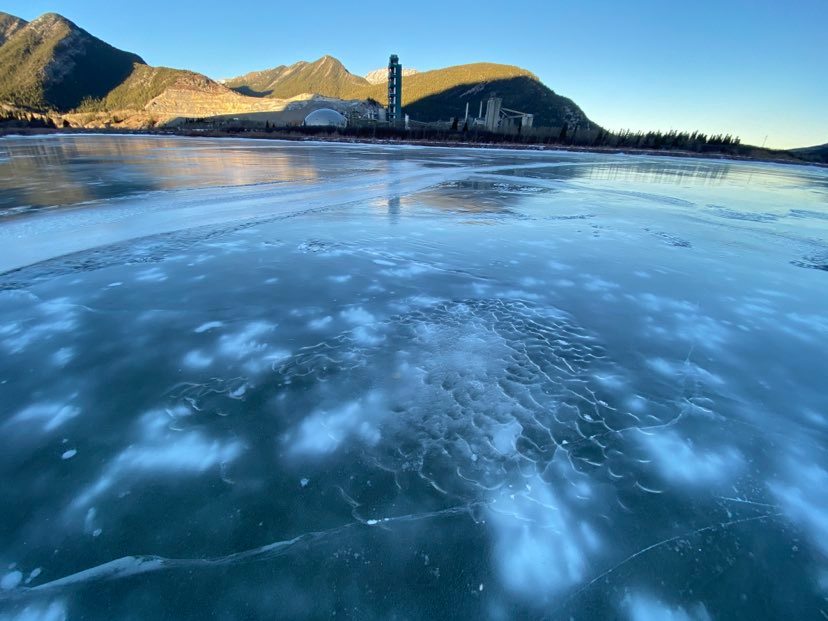
Vermillion Lakes
Vermillion Lakes is a network of marshlands and expansive lakes close to the town of Banff. In summer, they’re busy with photographers and paddlers.
In winter, they’re busy with ice skaters exploring the remote creeks and ponds. The area offers spectacular views of Mount Rundle and Sulphur Mountain. If you want to watch sunrise or sunset, this is the place to visit.
The access road is near the west entrance into the town of Banff and you can park near a small dock where you can lace up. Even after snow, locals with shovel rinks where you can get a decent skate in.
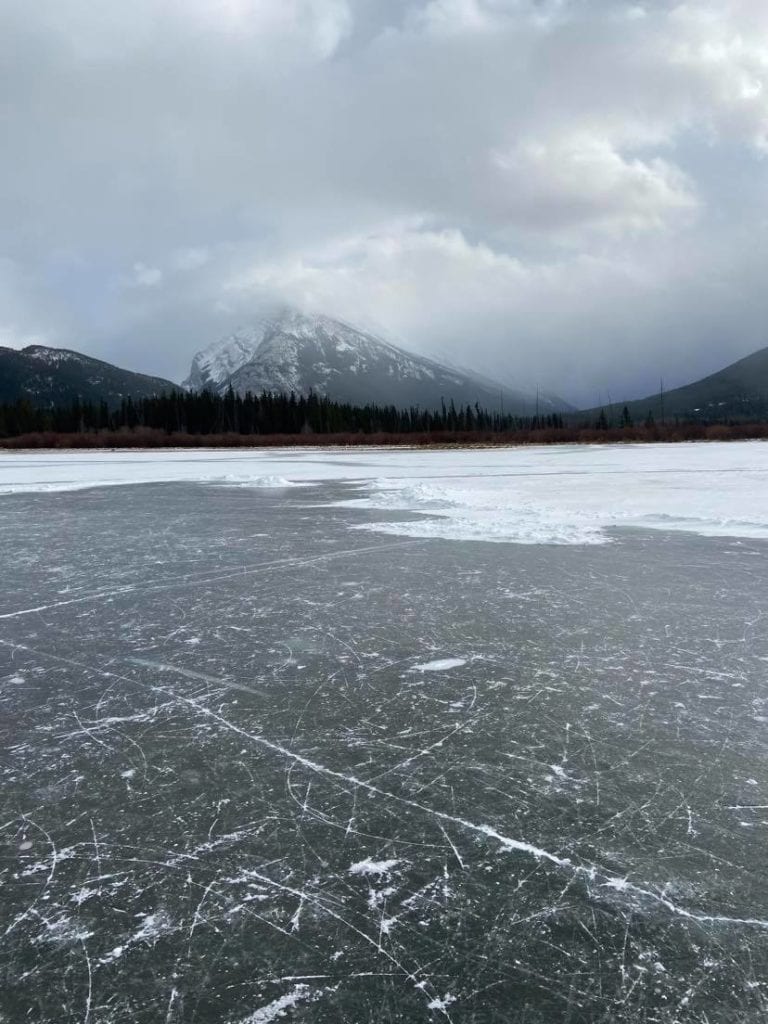
Lake Louise
Lake Louise is one of Alberta’s most-visited lakes in summer, fall, winter and spring. Each season offers different adventures, but in winther it’s the skating people visit for.
In November 2020, the entire lake froze with about three inches of clear ice covering it from shore to shore. It offered a unique place to ice skate and had people travelling from B.C. to explore it. Snow eventually covered the lake, but large rinks are maintained on the lake until spring.
Of all of the lakes on this list, Lake Louise is the most family friendly.
Backcountry Skating Tips
Visually inspect the area: Upon arriving, take a look around to see if others have been there. Look for cracks, pressure ridges, dark areas (thinner ice) and slushy areas. Look for open water and objective hazards like rocks. Look for frozen bubbles, they can sometimes help you gauge thickness.
Measure the ice: The Canadian Red Cross suggests: 15 cm (~5 inches) for walking or skating alone, 20 cm for hockey and 25 cm for snowmobiles. Typically, backcountry skaters will avoid anything less than 7 cm (~3 inches). Ice conditions vary from lake to lake.
Measuring in one place is not enough, be sure to take measurements in several different areas to ensure that the entire area is safe. Read more about measuring ice before heading out.
Ice colour: The colour of ice may be an indication of its strength. Clear blue ice is strongest. White opaque or snow ice is half as strong as blue ice. Opaque ice is formed by wet snow freezing on the ice. Grey ice is unsafe. The grayness indicates the presence of water.
Bring a shovel: It’s rare to find backcountry ice that doesn’t have fresh snow or snow drifts. Skate with a shovel to clear and inspect the area as you go.
Bring a headlamp: It can get dark quick and if you’re far from shore or your car, you’ll want to be able to find your way back without relying on the stars.
Wear a helmet: Skiers, climbers, paddlers and bikers wear them, so skaters should too. Get in the habit of wearing a helmet on backcountry lakes. You never know when you’ll catch an edge in a crack or hit a rock and take a tumble.
Wear a life jacket (PFD): If you’re exploring a remote lake or are unsure of the ice quality, then bring a life jacket. More than one skater has gone into the water and lived because they wore one.
Know rescue techniques: Rescuing another person from ice can be dangerous. The safest way to perform a rescue is from shore. Call for help. Consider whether you can quickly get help from trained professionals (police, fire fighters or ambulance) or bystanders.
Check if you can reach the person using a long pole or branch from shore – if so, lie down and extend the pole to the person. If you go onto ice, wear a PFD and carry a long pole or branch to test the ice in front of you.
Bring something to reach or throw to the person (e.g. pole, weighted rope, line or tree branch). When near the break, lie down to distribute your weight and slowly crawl toward the hole. Remaining low, extend or throw your emergency rescue device (pole, rope, line or branch) to the person. Have the person kick while you pull them out.
Self-rescue: If you get into trouble on ice and you’re by yourself: Call for help. Resist the immediate urge to climb back out where you fell in. The ice is weak in this area. Try to relax and catch your breath. Turn yourself toward shore so you are looking at where you entered onto the ice.
The ice is more stable close to shore. Reach forward onto the broken ice without pushing down. Kick your legs to try to get your body into a horizonal position. Continue kicking your legs, and crawl onto the ice. When you are back on the ice, crawl on your stomach or roll away from the open area with your arms and legs spread out as far as possible to evenly distribute your body weight.
Do not stand up! Look for shore and make sure you are crawling in the right direction.
Bring a stove: Bring a backcountry stove to boil water for a hot beverage beore and after your skate. If you’re planning to stay out all day, there’s nothing better than a hot lunch. For a review of the best 2020 stoves visit here.
Warm clothes in car: It can get cold on the lake, so having dry and warm clothes waiting for you in the car can make the drive home a lot nicer. Maybe throw a warm sleeping bag in there to wrap yourself in. For nine three-season sleeping bags visit here.
